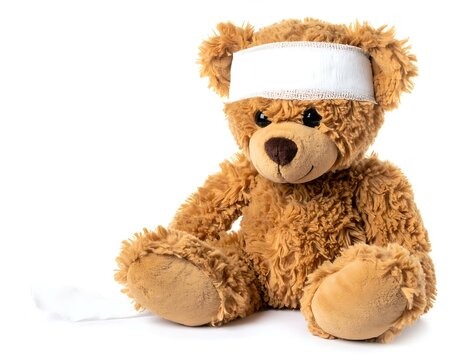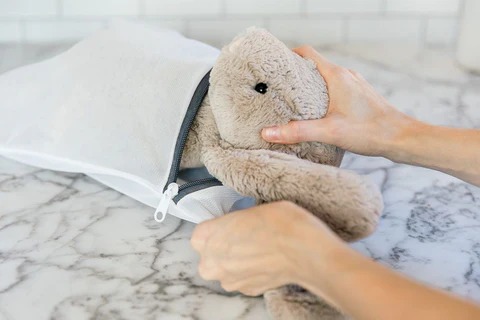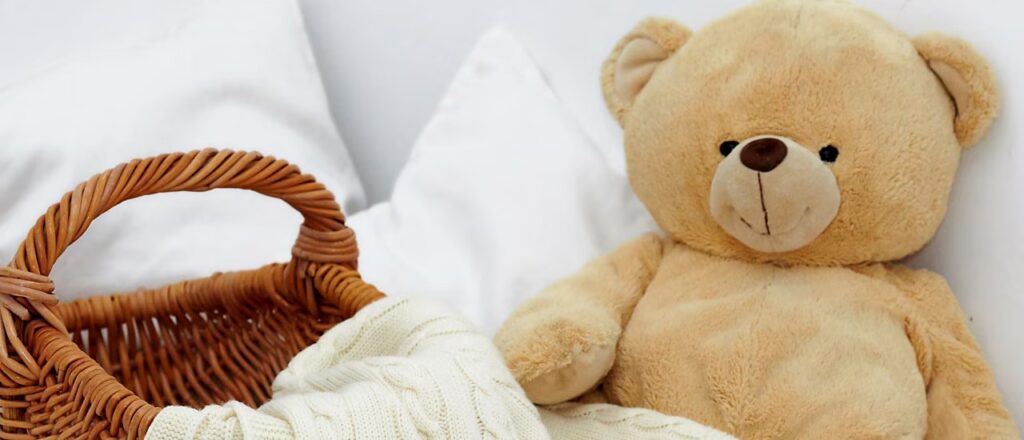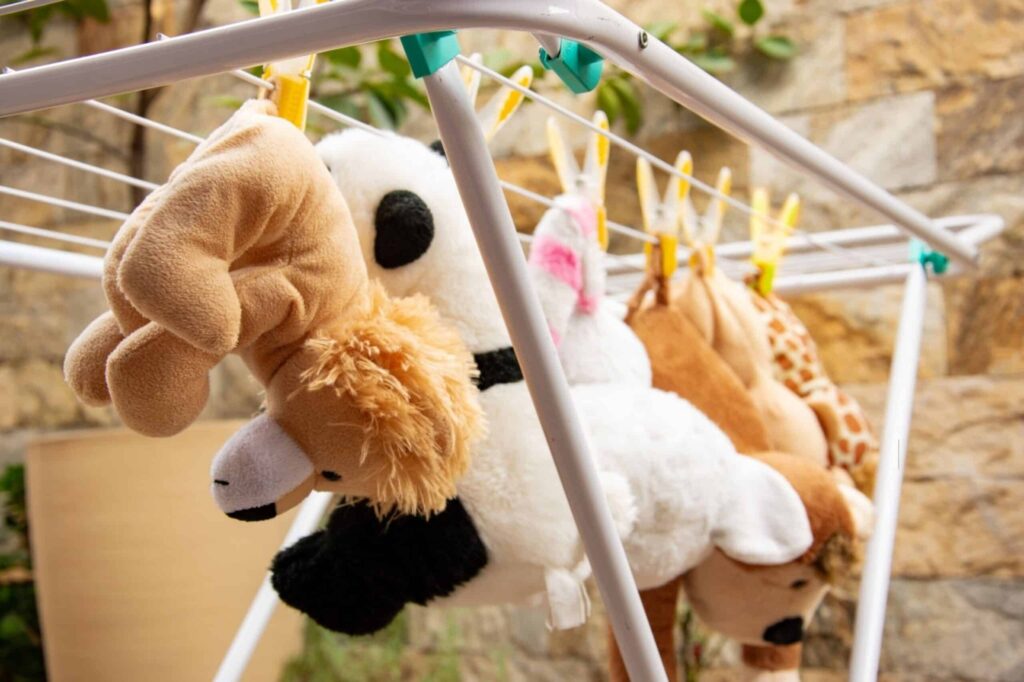Plush stuffed animals aren’t just cute companions—they’re emotional treasures, childhood keepsakes, and even on-trend collectibles. But what happens when your beloved plush friend gets a little too well-loved, picking up dust, stains, or even unwanted odors? Many people worry that cleaning a plush toy will damage its softness or ruin its look. Fortunately, with the right approach, you can refresh and care for plush toys without compromise.
The safest way to clean a plush stuffed animal is to check its care label, choose a gentle cleaning method (such as hand washing or spot cleaning), and use mild detergents. Proper drying and careful handling preserve softness, shape, and durability—keeping plush toys fresh and long-lasting.
If you’ve ever worried about tossing a favorite stuffed animal into the wash or scrubbing away a stubborn stain, you’re not alone! In this guide, we’ll break down every step, debunk myths, and even share pro tips from plush toy experts. Whether you’re a parent, a collector, or a business, you’ll discover how easy it is to keep your plushies clean, fluffy, and ready for more hugs.
1. What Are the Common Reasons for Cleaning Plush Stuffed Animals?

Plush stuffed animals need cleaning to remove dirt, dust, stains, allergens, and odors, ensuring they remain safe and hygienic for everyday use.
Why Clean Plush Toys Regularly?
- Allergy Prevention:
Dust and allergens can accumulate, affecting sensitive children or adults. - Hygiene for Kids:
Babies and toddlers often chew or cuddle plush toys, so cleanliness is key for health. - Appearance & Longevity:
Regular cleaning maintains the plush’s color, texture, and structure, prolonging its life. - Collectible Value:
For collectors, keeping toys clean and odor-free preserves their market value.
Example:
A plush animal kept on a bed can pick up dust mites within weeks, while one played with outdoors may show stains and lose its softness faster.
Common Reasons for Cleaning Plush Toys
| Sebep | Etki | How Often to Clean |
|---|---|---|
| Alerjiler | Reduces sneezing, itching | Every 1-2 months |
| Hijyen | Prevents bacteria build-up | Monthly or as needed |
| Stains/Odors | Improves appearance/smell | Spot clean as needed |
| Koleksiyon Ürünleri | Maintains value | Before storage/sale |
2. Which Cleaning Methods Are Safe for Plush Stuffed Animals?

The safest cleaning methods for plush toys are hand washing, spot cleaning, and, for some, gentle machine washing. Always check the care label first.
Evaluating Cleaning Methods
- Hand Washing:
Best for delicate or older plushies. Controls water temperature and agitation. - Leke Temizliği:
Ideal for removing minor stains or spills on non-washable toys. - Machine Washing:
Suitable for most modern plushies with durable stitching. Use a gentle cycle and place toys in a mesh laundry bag. - Dry Cleaning:
Only for specialty or antique plush toys, especially those with electronic components. - Surface Cleaning:
Quick wipe-downs with damp cloths and mild soap—good for toys with glued-on features or accessories.
Example:
A plush toy with plastic eyes and embroidery can usually be machine washed, but one with delicate trims or electronics should only be spot cleaned or surface cleaned.
Plush Toy Cleaning Methods Comparison
| Yöntem | İçin En İyisi | Risk Level | Gerekli Zaman | Notlar |
|---|---|---|---|---|
| Hand Wash | Delicate, vintage | Düşük | 20-30 min | Gentle, most universally safe |
| Spot Clean | Minor stains | Very low | 5-10 min | Fast, targeted cleaning |
| Machine Wash | Durable, new toys | Orta | 45-60 min | Use gentle cycle, mesh bag |
| Dry Clean | Specialty, antiques | Düşük | 1-2 days | For valuable or rare toys |
| Surface Clean | Toys with electronics | Very low | 5-10 min | Avoids water inside toy |
3. How Do You Check If a Plush Stuffed Animal Is Machine Washable?

You can check if a plush stuffed animal is machine washable by reading the care label, examining the toy for delicate or electronic parts, and testing fabric colorfastness.
Steps to Assess Machine Washability
- Read the Label:
Most modern plush toys have a sewn-in tag with cleaning instructions. Look for symbols or wording like “machine washable” or “hand wash only.” - Inspect for Attachments:
Toys with glued features, batteries, or electronic music boxes should not go in the washer. - Check Seams and Stitching:
Weak or vintage seams might unravel in the machine. - Test for Colorfastness:
Dab a damp white cloth on a hidden area; if color transfers, avoid machine washing. - Assess Filling Material:
Polyester fiberfill is usually safe, but beans or foam beads may clump or deform.
Example:
A plush teddy bear with a music box and button eyes will likely need spot cleaning, while a modern polyester bunny can probably handle a gentle machine wash.
How to Check Machine Washability
| Checkpoint | Nelere Dikkat Edilmeli | Eylem |
|---|---|---|
| Care Label | “Machine washable” tag | OK to wash |
| Electronic Parts | Removable? Nonexistent? | Remove or avoid |
| Delicate Trim | Lace, ribbons, glue | Hand/spot clean |
| Filling Type | Polyester vs. beans | Wash or spot |
| Colorfast Test | No dye transfer | Wash |
4. What Supplies and Detergents Should You Use?

Use mild, fragrance-free detergents, soft brushes, and clean towels to clean plush toys safely. Avoid bleach or harsh chemicals that can damage fabric or colors.
Essential Cleaning Supplies
- Detergents:
Choose baby laundry detergent, gentle soap, or plant-based cleaners—these are safe for sensitive skin. - Brushes:
Use a soft-bristled toothbrush for stains or hard-to-reach areas. - Towels/Cloths:
Microfiber towels help soak up water without damaging fibers. - Laundry Bags:
Mesh laundry bags protect toys during machine washing. - Optional:
Baking soda for deodorizing, white vinegar (diluted) for tough stains.
Example:
For a plush elephant covered in chocolate stains, a mix of gentle detergent and baking soda can lift stains while keeping the toy soft.
Recommended Supplies for Plush Toy Cleaning
| Supply | Kullanım Örneği | Notlar |
|---|---|---|
| Baby Detergent | All cleaning methods | Hypoallergenic, gentle |
| Soft Toothbrush | Spot cleaning, stains | Avoids damaging fabric |
| Microfiber Towel | Drying, blotting | Absorbs water efficiently |
| Mesh Laundry Bag | Machine washing | Prevents stretching/tears |
| Baking Soda | Deodorizing, stain removal | Sprinkle, then vacuum |
5. How Do You Hand Wash a Plush Stuffed Animal Without Damaging It?

Hand washing a plush stuffed animal safely involves using cool or lukewarm water, gentle detergent, and avoiding harsh scrubbing. Squeeze, don’t twist, and rinse thoroughly.
Step-by-Step Hand Washing
- Prep:
Remove accessories or clothes from the plush toy. - Mix Cleaning Solution:
Fill a basin with cool/lukewarm water and a splash of mild detergent. - Wash:
Submerge the toy, gently squeeze soapy water through the plush, focusing on dirty areas. - Spot Clean Tough Stains:
Use a toothbrush or cloth for targeted stains. - Rinse:
Drain soapy water, refill with clean water, and gently rinse the toy until all soap is gone. - Remove Excess Water:
Press the toy between towels to remove moisture—don’t wring or twist, which can deform the filling.
Example:
A plush dinosaur that survived a toddler’s picnic can be gently cleaned this way, restoring its bright color and soft feel.
Hand Washing Steps at a Glance
| Adım | Ne Yapmalı |
|---|---|
| Prep | Remove loose parts, check for tears |
| Soak | Submerge in cool/lukewarm soapy water |
| Wash | Gently squeeze, avoid twisting or scrubbing |
| Spot Clean | Brush or dab stains with detergent |
| Rinse | Repeat with clean water |
| Dry | Press with towel, air dry |
6. What Is the Best Way to Remove Stains and Odors?

To remove stains and odors from plush toys, use a mixture of mild detergent and water, apply gently to stained areas, and treat odors with baking soda or diluted vinegar.
Tackling Tough Stains & Odors
- Spot Treating:
Apply a paste of baking soda and water for tough spots; let it sit, then brush off. - Deodorizing:
Sprinkle baking soda over the plush, leave for 15-20 minutes, and vacuum gently. - Protein Stains (milk, blood):
Use cold water and a tiny bit of enzyme-based detergent. - Grease or Oil:
Cornstarch can help lift oily stains—sprinkle, wait, brush off, then wash as usual. - Odors:
For stubborn smells, use diluted white vinegar in a spray bottle; spritz lightly and air dry.
Example:
A plush bunny with a juice stain and musty smell can be spot cleaned and deodorized, restoring it to like-new condition.
Stain and Odor Solutions
| Stain/Odor Type | Çözüm | How to Apply |
|---|---|---|
| Food/Drink | Mild detergent + water | Dab, rinse |
| Mud/Dirt | Soft brush + soapy water | Scrub gently, rinse |
| Odors | Baking soda or vinegar spray | Sprinkle or spritz, dry |
| Oil/Grease | Cornstarch, then hand wash | Dust, brush, clean |
| Protein (milk, etc) | Cold water + enzyme detergent | Soak, rinse |
7. How Do You Dry and Fluff a Plush Stuffed Animal After Cleaning?

To dry a plush stuffed animal, press out water with towels and air dry in a well-ventilated area. Fluff with your hands or a hair dryer on cool setting.
Proper Drying & Fluffing Methods
- Towel Drying:
Gently roll the toy in a towel to absorb as much water as possible. - Hava ile Kurutma:
Place the plush on a rack or hang with clothespins in a shaded, breezy spot. - Tumble Drying:
If the care label allows, use a dryer on the lowest heat setting. Toss in a clean tennis ball to help restore fluff. - Fluffing:
Once dry, gently brush the plush with a clean toothbrush or use your hands to reshape and fluff the fur. - Avoid Direct Sunlight:
Prevents fading or fabric damage.
Example:
A large plush bear will dry best laying flat on a rack, then can be fluffed and brushed to look brand new.
Drying and Fluffing Options
| Yöntem | İçin En İyisi | Notlar |
|---|---|---|
| Towel Dry | All plush toys | Avoids waterlogging |
| Air Dry | Çoğu peluş | Prevents fabric shrinkage |
| Tumble Dry (Low) | Durable, new | Use mesh bag/tennis ball |
| Fluff by Hand | All plushies | Restores softness |
| Brush Fur | Long-pile toys | Prevents matting |
8. Are There Special Care Tips for Eco-Friendly or Delicate Plush Toys?

Eco-friendly or delicate plush toys require extra care—use organic detergents, avoid machine washing, and always dry naturally to protect their sustainable materials.
Caring for Sensitive or Luxury Plush
- Organic Materials:
Use plant-based, chemical-free detergents to prevent fiber breakdown. - Hand Wash Only:
Many sustainable or luxury plush toys aren’t designed for machines. - Low-Temperature Water:
Keeps organic dyes and fibers from fading or shrinking. - Skip Fragrance or Softener:
These can damage delicate fibers or cause allergic reactions. - Storage:
Keep plushies in breathable cotton bags instead of plastic to avoid mildew.
Example:
A collectible organic cotton plush fox can be hand washed with plant-based soap, then air dried and stored in a fabric bag for years of use.
Special Care for Eco-Friendly Plush Toys
| Care Step | Recommendation | Neden Önemli? |
|---|---|---|
| Deterjan | Organic, fragrance-free | Prevents residue/allergy |
| Water Temperature | Cool or lukewarm | Protects fibers/dyes |
| Kurutma | Air dry, no direct sun | Maintains color/shape |
| Depolama | Cotton bag, dry place | Avoids mold/mildew |
Cleaning plush stuffed animals doesn’t have to be a guessing game. With the right methods, supplies, and a bit of care, you can keep every plushie looking as good as new—no matter how many adventures they go on! Whether you’re a parent looking to protect your child’s favorite toy, a collector safeguarding your investment, or a business needing care tips for your product line, these practical steps ensure plush toys remain safe, hygienic, and huggable for years to come.
Looking for more expert care tips, or interested in custom plush solutions for your brand or retail business?
İletişim Kinwin for personalized plush toy production, private label solutions, or wholesale inquiries. Our team of plush toy professionals is here to help your business stand out—with quality, sustainability, and irresistible cuteness built in every stitch.




